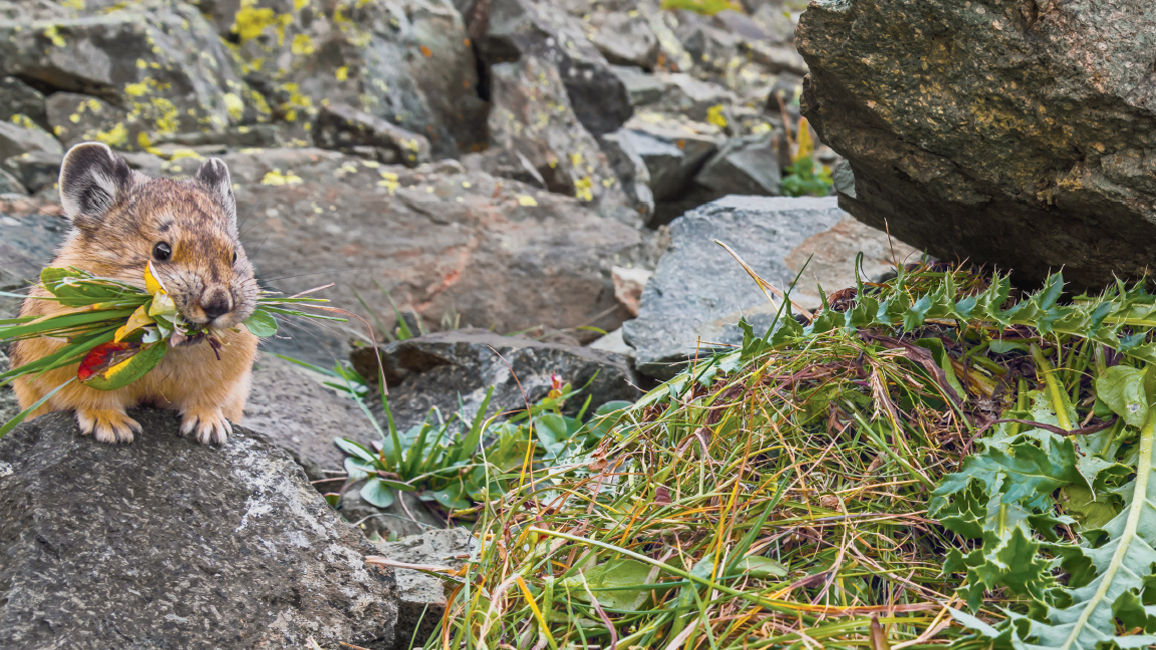
Super Savers
By Hannah SchardtWhen there’s more than enough food to eat in one season, these clever animals deposit some in a “savings account” for another day.
The American pika in the photo above isn’t bringing a bouquet to a sweetheart. The fuzzy mountain mammal—a cousin of rabbits and hares—is gathering leaves and grass for its haypile. A haypile is not a nest. It’s a huge mound of plant bits that the pika can munch on during the long, harsh winter ahead.
All sorts of animals—even people—store extra food for times when there’s not enough fresh food to eat. When wild animals such as the pika do it, it’s called hoarding or caching (CASH-ing).
Often, animals store food during the summer and fall to eat during winter. For example, the family of acorn woodpeckers in the circle above right pecks out hundreds of acorn-sized holes in a dead tree. Then they stuff each hole with a single acorn. Once filled, the tree is called a granary (GRAY-nuh-ree). When winter arrives and fresh acorns are scarce, the birds return to the granary to fill their bellies with the acorns they’ve stored.
Some animals store food for only a day or two. Still others pluck unripe fruit from trees and hide it until it’s ready to eat.
All of these food stashes are like savings accounts for hungry animals. And when times are tough, a food “withdrawal” can make the difference between surviving and starving.
Hoping to hide its meal from scavengers, the leopard at left drags an antelope it killed into the safety of a tall tree. The big cat will return to its prey several times over the next week to eat—if a vulture doesn’t swoop in first to finish off the meaty meal.
Keep It Together
Some animals, such as wild hamsters, store all their food in just one or two big collections, or caches. This is known as larder hoarding. (A larder is a place to save up food.) There are a few reasons why it works well for the animals that do it. For one, larder hoarders have no trouble remembering where their food is stored. For another, it’s easier to fight off a hungry thief when there’s only one pile to defend. But when an animal “puts all its eggs in one basket”—or all its nuts and seeds in one burrow—it risks losing everything at once if another animal raids the cache.
Spread It Around
When you see a squirrel digging a bunch of little holes all over your backyard, hiding a single acorn in each, that’s scatter hoarding. Squirrels and other scatter hoarders hide small bits of food in a bunch of different places. Of course, a scatter hoarder can’t defend all that food against scrounging animals. And the hoarder may forget where some items are hidden. But when winter rolls around, there’s a good chance the hungry animal will find that at least some of its hidden tidbits are still there.
In the dark of night in Costa Rica, a tayra (TYE-ruh) sneaks off to hide an unripe plantain in a secret spot. After a few days, this weasel relative will return to devour the fruit, which will then be soft and ripe.
The golden hamster at left makes hundreds of trips—cheeks chock full of corn and wheat—to fill its tasty “savings account.”
That’s Nuts!
When the owner of this car opened the hood to check out a funny smell, he discovered that a mouse had filled the space with peanuts! Who needs an underground burrow or a hollow tree when you’ve got a Volvo?
Hey! These are MY acorns! An acorn woodpecker angrily flaps its wings, trying to scare off a squirrel that wants to steal from the bird’s hard-earned stash.
Who, me? A grizzly bear looks a little guilty when caught in the act of stealing pine nuts from a squirrel’s snow-covered cache.
A gray squirrel buries a nut for later. Too bad a crow is watching nearby—and plotting a theft!
Tricky Savers
Some super savers are super tricky. When a gray squirrel thinks another squirrel or a thieving bird is watching, it may dig a hole and pretend to bury a nut. Then it scampers off to hide the nut somewhere more private. Scientists have found that many squirrels are able to find more than half of their hidden caches—even though a single squirrel may hide thousands of nuts in a single year!
But even the cleverest super savers sometimes lose their stashes. They may forget where they buried them. Or other animals may rob their caches. So they start collecting food all over again. After all, money doesn’t grow on trees. But fruits, nuts—and lots of other foods worth saving—do!
“Super Savers” originally appeared in the November 2017 issue of Ranger Rick magazine.



















